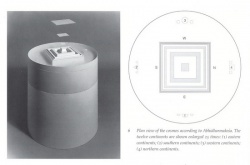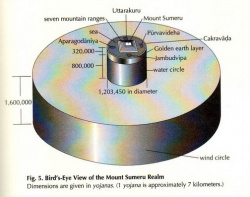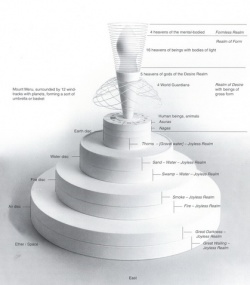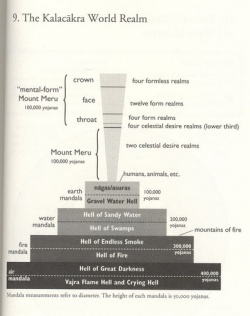Tibetan Cosmological Models
Fundamental to the Tibetan worldview is the artistic and symbolic representation of the cosmos (or some aspect of it, such as the palace of a specific meditational deity) called a mandala. Although representing a three-dimensional structure, mandalas can be two-dimensional paintings on cloth as well as the famous temporary sand mandalas created for specific rituals. Mandalas can also be generated mentally, or symbolized through intricate hand gestures called mudras.
In Tibetan astro science, two distinct flat-earth, stationary, geocentric cosmologies are recognized, both developed in India and later translated into Tibetan. The first is the Abhidharma system, expounded in the 4th or 5th century Indian text Abhidharmakosha (Treasury House of Knowledge) by Vasubandhu, and the Kalachakra system (Wheels of Time), whose root text was translated into Tibetan in 1027 A.D.. Both systems are mandala-like world systems made of concentric oceans and mountain ranges centered around an axis, Mount Meru. The known world exists on one of the four major continents (with other minor accompanying continents), the southern continent, called Jambudvipa. Mount Meru is lapis-blue on our side, which explains why it cannot be seen, but instead blends in with the sky's color.The heavenly bodies orbit around Mount Meru. The cosmic mandala pictured in the header above shows a bird's-eye view of Mount Meru and the orbits of the planets (including sun and moon).The world system, with its complex layered base, floats in space, and is only one of an immense number of such world systems, termed the trichilicosm (a number usually considered to be over a billion).
The most obvious differences between the two cosmological systems are geographic and geometric, such as the shape of Mount Meru. Compare the pictures below for more details. To the Tibetans, the existence of two seemingly conflicting cosmological systems is not a problem, as neither is meant to be a complete representation of the universe as it is actually observed by scientists. As with all constructions such as mandalas and meditational deities, they serve different purposes and different audiences. For example, the Kalachakra cosmology is used philosophically to draw connections between cycles in the universe and those of human existence, and in an astronomical sense to develop a complex lunar calendar. Another central idea in Tibetan Buddhism is the concept that The Buddha taught many different kinds of texts and meditational systems because there is no "one size fits all" when it comes to the road to Enlightenment. Different practitioners have different intellectual and emotional capacities, and therefore different teachings are required to reach all possible students.
As with other ancient and cultural cosmologies, the Tibetan universe is composed of the classic elements fire, earth, air, and water. These four elements exist and function through a fifth element, space. The parallels between these cosmologies and other geocentric models makes them interesting examples to include in lesson plans centered on ancient cosmologies, such as the GEMS activity “Ancient Models of the World”. In this activity, students are directed to make their own artistic representation of a cosmological model. Tibetan cosmologies are an excellent tie-in, as three different mandalas can be used as illustration: the Kalachakra mandala (a painting on cloth or sand mandala representing the concentric strata of the palace of the meditational deities at the heart of Mount Meru), the Cosmic (or wind tracks) mandala of interlocking circles which represents the paths of the heavenly bodies, and the mandala offering, a mudra made with two hands which represents Mount Meru and the four main continents. Illustrations of each of these can be found here. Students can also construct three-dimensional models of the Abhidharma and Kalachakra cosmologies based on photographs of such models found in Brauen (1997).
The concept of impermanence is central to Tibetan Buddhism, including world systems within the larger eternal universe. Just as the individual sentient being is born, dies, and is reborn, so too does the universe transmigrate. As in Hinduism, any cosmological system is seen to come into being, exist for billions of years (a kalpa), then dissolve, before coming into existence again. However, one fundamental difference between the Tibetan and Hindu cyclical universe is the cause of the cycle. In Hinduism, the cause is a trio of deities (Brahma, Vishnu, and Shiva) while in Tibetan Buddhism the cause is considered to be natural and not supernatural or transcendental. In the Abhidharma system, mere potentiality exists between times of dissolution and creation, as all particles of the five elements disappear. In the Kalachakra system, so-called space particles are the link between cycles.
If we follow the evolution of a particular universe (world system), will see four stages: (1) Emptiness (the era of space particles), (2) Formation, (3) Abiding, and (4) Destruction. At the destruction of one system, the fire, earth, air, and water particles separate and perhaps even fall apart, but space particles remain. This is the stage of Emptiness. When motivated through the accumulated Karma of all the Sentient beings that existed in the previous world system, the space particles begin the process of forming a new universe from the reformed elements. First air particles coagulate to form wind, which then causes the fire particles to join and create lightning. From this process water particles form rain, and the resulting rainbows herald the joining of earth particles.
The order of this "creation" is mirrored in the structure of the world system in the Abhidharma and Kalachakra systems depicted above, with the air disk being the lowest layer of the base of the world, topped in succession by disks of fire, water, and earth. Sentient beings begin to populate all possible realms (e.g. various hell realms, animal, human, and deities). During this stage, humans are granted an "infinite" lifespan (until the end of the age). When this process is complete, the Stage of Formation ends. The Stage of Abiding is subdivided into many eras, in which the lifespan of humans changes. We are currently said to be in a degenerate age, when the lifespan is decreasing and is about 80 years.
The Stage of Destruction begins when no more Sentient beings are reborn in the hell realms, and the hells begin to empty out (as various beings exhaust the Karma that brought them there in the first place). Likewise, all higher realms of existence are emptied out in sequence. Finally the world system is destroyed by a great fire. According to the Abhidharmakosha there are also higher cycles where every 8th destruction is accomplished by a flood, and every 8th of those cycles, by a great wind, leading to a "great cycle of destruction."
This process is eternal and without beginning or end, and in a sense defines time itself (as a series of changes of impermanent reality).
Numerous scientists have found the philosophical parallels between these cosmologies and modern cosmology to be worthy of discussion, similarities which could be incorporated into discussions of ancient and modern cosmologies in elementary astronomy classes (e.g. Zajonc 2004).
For more information, consult the following sources:
Astro Department (1995) Tibetan Astronomy and Astrology - a Brief Introduction. Dharamsala,India: Tibetan Medical and Astro Institute.
Berzin, Alexander (1997) Taking the Kalachakra Initiation. Ithaca, NY: Snow Lion Press.
Brauen, Martin (1997) The Mandala: Sacred Circle in Tibetan Buddhism. Boston: Shambala Publications.
Dalai Lama (2005) The Universe in a Single Atom. NY: Morgan Road Books.
Gyatso, Khendrup Norsang (2004) Ornament of Stainless Light: An Exposition of the Kalachakra Tantra. Boston: Wisdom Publications.
Ricard, Matthieu and Trinh Xuan Thuan (2001) The Quantum and the Lotus. NY: Crown Publishers.
Sadakata, Akira (1997) Buddhist cosmology: Philosophy and Origins. Tokyo: Kosei Publishing
Wallace, B. Alan, ed. (2003) Buddhism and Science: Breaking New Ground. NY: Columbia University Press.
Zajonc, Arthur, ed. (2004) The New Physics and Cosmology: Dialogues with the Dalai Lama. NY: Oxford University Press.



